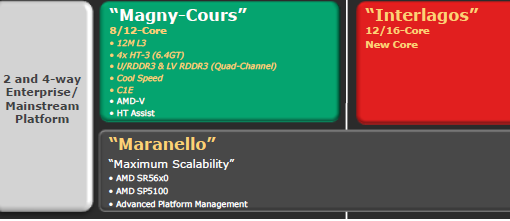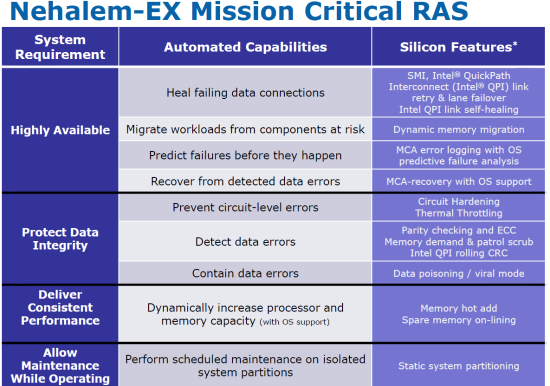AMD's 2010/2011 Roadmap from the IT Professional’s Perspective
by Johan De Gelas on November 23, 2009 12:00 AM EST- Posted in
- IT Computing
Server CPUs in 2010
AMD’s best core in 2010 is a slightly improved revision of the current six-core Opteron “Istanbul” with the following additions:
• Finally a “real” C1E state which reduces power for each core that is idleing
• Support for DDR-3
In theory, DDR-3 1333 offers 66% higher bandwidth, but in practice the Stream benchmark does not measure more than a 25% boost in bandwidth. The latency of going off-die is about the same. That means that the performance increase in most server applications will not be tangible. Only the most bandwidth intensive HPC applications will get a boost of 10 to 20%.
Currently, AMD's six-core Opteron can match the performance of Intel’s quadcore Xeon 5500 at the same clockspeed in some important server applications: OLAP databases, virtualization and web applications. Intel’s best Xeon wins with a significant margin in OLTP, ERP and rendering. A large part of the HPC market is a lost cause: a quadcore Intel Xeon 5570 at 2.93 GHz is about twice as fast as a AMD Opteron 2389 at 2.9 GHz. The fact that we could not find any Opteron 2435 results in LS-Dyna is another indication of what to expect: the 10-20% higher performance in HPC applications will not be a large step forward.
Intel is going to increase performance by 20-30% per CPU (50% more cores), while AMD’s CPUs will see only marginal increases. So basically, Intel’s performance advantage is going to grow by 20 to 30%, except in HPC workloads where it is already running circles around the competition. Not an enviable position to be in for AMD.
Suppose that you are the strategic brain behind AMD. The competition offers better “per chip” and “per core” performance. The last thing you want to do is to offer the same kind of server platform. If a six-core Opteron (“Lisbon") goes head to head with a six-core Xeon (“westmere EP”), it will not be pretty: the Intel chip will beat the AMD chip in performance and performance/watt (remember, westmere EP is a 32 nm CPU). Despite this, AMD found some clever ways to make their server platforms interesting…
Cheaper 4-Socket Servers

“Know your enemies and know yourself”.
In which usage scenario’s are Intel’s offerings less compelling? The Nehalem-EX is a powerful platform, but it is also a completely different one than the “Westmere EP” platform. The Nehalem-EX's most important market is the 4-socket/8-socket x86 market, where about 400,000 servers are sold per year, or about 5% of the total x86 server market. It is also a pretty complex platform with two I/O hubs and 16 (!) memory buffers chips on a 4-socket board. The Nehalem EX platform does not only want to conquer the high end 4 and 8-socket x86 server market, it also wants to convince the more paranoid RISC and Itanium buyers:

Our first impression is that AMD will find it hard to win the high end database and ERP market. The quadcore Nehalem 5500 already outperforms the six-core Opteron “Istanbul” by a large margin (30-50%). The Opteron 6100 also has 50% more cores, but it is likely that a “native octalcore” will scale a bit better than a two times 6-core design. For the virtualization market, the higher amount of DIMM slots are an advantage for the Nehalem EX. At first sight, it looks like it will be pretty tough for AMD to regain market share in this part of the server market.










107 Comments
View All Comments
nafhan - Tuesday, November 24, 2009 - link
The numbers imply a 20% - 35% improvement per core.12*1.6/16=1.2 and 12*1.8/16=1.35
qcmadness - Tuesday, November 24, 2009 - link
it would be nowhere enough to compete with Nehalem / Sandybridge (with >100% more integer performance in server applications)4lpha0ne - Tuesday, November 24, 2009 - link
If you are concerned about the FP performance, then have a look at this blog: http://citavia.blog.de/">http://citavia.blog.de/ (it's in English).Paladin1211 - Tuesday, November 24, 2009 - link
"The Opteron 6100 also has 50% more cores"It has 12 cores, 100% more than an Istanbul, and 200% more cores than Nehalem 5500.
Paladin1211 - Tuesday, November 24, 2009 - link
Oh, sorry, you meant the Nehalem EX, I misread the sentence :DGourdFreeMan - Tuesday, November 24, 2009 - link
Johan De Galas wrote:"It was hardly noticeable but AMD made a historic step forward in September 2009 with the introduction of it’s own server chipsets. For the first time, AMD is a real server platform supplier, in control of both the CPU and chipset."
Not true. AMD was the original supplier of chipsets for its Opteron processors. Remember the AMD 8000 series chipsets?
brshoemak - Tuesday, November 24, 2009 - link
I was thinking the same thing, so I looked:http://www.amdboard.com/opteron_chipsets_amd.html">http://www.amdboard.com/opteron_chipsets_amd.html
http://www.amd.com/us-en/Processors/ProductInforma...">http://www.amd.com/us-en/Processors/Pro...ion/0,,3...
http://www.amd.com/gb-uk/Corporate/VirtualPressRoo...">http://www.amd.com/gb-uk/Corporate/Virt...sRoom/0,...
JohanAnandtech - Tuesday, November 24, 2009 - link
I do not disagree, but understand that these chipsets were "good enough to get the platform going" efforts. IIRC, all these chipsets were not exactly the state-of-art chipsets, they lacked quite a few features. I remember the AMD760MP having no real support for USB for example. These were decent stable chipsets, but AMD just produced because they wanted VIA and NVIDIA to take over. As soon as Nvidia produced enough nForce Pro chipsets, I remember seeing very few 8000 chipset based servers.It is a whole different situation today. I agree I might have oversimplified, but still I think there is evidence enough: AMD is going the Intel way, taking full control of its own server platform and providing state-of-the art chipsets.
themelon - Tuesday, November 24, 2009 - link
But your statement "For the first time, AMD is a real server platform supplier" is just plain wrong.AMD's 8000 lineup was used in almost all of the first and the majority of the second generation Opteron platform systems. Even in many systems that employed the nForce4 and MCP55 derivatives would still have an 8131/2 PCI-X chip on it as it was the only device that could do PCI-X attached to a HT link for several years.
It is true that there intention in having the lineup was primarily to get the overall platform going. That did not stop it from being a very solid and well selling platform though.
niva - Tuesday, November 24, 2009 - link
Ummm no, I have a Tyan Thunder K7 760 MP board and it supports USB (first gen) just fine, the via and nVidia derrivatives of that chipset sucked imo. That's among the most solid boards I've ever purchased. I still use that computer to this day and it is not a gimmick. You can spin it whatever way you want but AMD introduced features with that chipset that other companies like VIA and nVIDIA were too stupid to create at the time. I'll agree that it wasn't their intent to be the main player in the chipset industry at the time but the fact you reported on is incorrect, you can go and fix it.